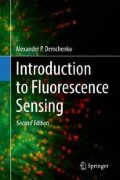Abstract
Quantitative measures are highly needed in fluorescence sensing. In this Chapter the reader finds discussion on parameters that have to be optimized in every sensor, such as selectivity, sensitivity and limit of detection. Concentrating on reversible binding, in which the mass action law is observed, the methods of determining the binding constants and modeling the ligand binding isotherms are presented. Kinetics of target binding and its influence on the results of analyte determination are discussed. Focusing on fluorescence sensing, linear and intensity-weighted formats are distinguished and analyzed. At the end of this Chapter the reader finds the Section “Sensing and thinking” with the list of questions and problems. It addresses the issue, how to provide the optimal quantitative measure of target binding.
Access this chapter
Tax calculation will be finalised at checkout
Purchases are for personal use only
References
Baker GA, Pandey S, Bright FV (2000) Extending the reach of immunoassays to optically dense specimens by using two-photon excited fluorescence polarization. Anal Chem 72(22):5748–5752
Bobrovnik SA (2003) Ligand–receptor interactions: a new method for determining the binding parameters. J Biochem Biophys Methods 55(1):71–86
Bobrovnik SA (2005) New capabilities in determining the binding parameters for ligand-receptor interaction. J Biochem Biophys Methods 65(1):30–44
Bobrovnik SA (2007) The influence of rigid or flexible linkage between two ligands on the effective affinity and avidity for reversible interactions with bivalent receptors. J Mol Recognit 20(4):253–262
Bobrovnik SA (2008) A simple and convenient approach for evaluation of the parameters of ligand–receptor interaction. Receptor blocking index and its application. J Mol Recognit 21(2):96–102
Bobrovnik SA (2014) Avidity of polyreactive immunoglobulins. Ukr Biochem J 86(6):183–189
Boens N, Leen V, Dehaen W (2012) Fluorescent indicators based on BODIPY. Chem Soc Rev 41(3):1130–1172
Carletti E, Guerra E, Alberti S (2006) The forgotten variables of DNA array hybridization. Trends Biotechnol 24(10):443–448
Demchenko AP (2010) The concept of lambda-ratiometry in fluorescence sensing and imaging. J Fluoresc 20(5):1099–1128
Demchenko AP (2014) Practical aspects of wavelength ratiometry in the studies of intermolecular interactions. J Mol Struct 1077:51–67
Demidov VV, Frank-Kamenetskii MD (2004) Two sides of the coin: affinity and specificity of nucleic acid interactions. Trends Biochem Sci 29(2):62–71
Eaton BE, Gold L, Zichi DA (1995) Let’s get specific: the relationship between specificity and affinity. Chem Biol 2(10):633–638
Gaugain B, Barbet J, Capelle N, Roques BP, Le Pecq JB (1978) DNA Bifunctional intercalators. 2. Fluorescence properties and DNA binding interaction of an ethidium homodimer and an acridine ethidium heterodimer. Biochemistry 17(24):5078–5088
Hong S, Leroueil PR, Majoros IJ, Orr BG, Baker JR Jr, Banaszak Holl MM (2007) The binding avidity of a nanoparticle-based multivalent targeted drug delivery platform. Chem Biol 14(1):107–115
Kellner R, Mermet J-M, Otto M, Valcarcei M, Widmer HM (2004) Analytical chemistry. Wiley-VCH, New York
Kitov PI, Bundle DR (2003) On the nature of the multivalency effect: a thermodynamic model. J Am Chem Soc 125(52):16271–16284
Klenin KV, Kusnezow W, Langowski J (2005) Kinetics of protein binding in solid-phase immunoassays: theory. J Chem Phys 122(21):214715
Klotz IM (1983) Ligand-receptor interactions – what we can and cannot learn from binding measurements. Trends Pharmacol Sci 4(6):253–255
Klotz IM, Hunston DL (1971) Properties of graphical representations of multiple classes of binding sites. Biochemistry 10(16):3065–3069
Kusnezow W, Jacob A, Walijew A, Diehl F, Hoheisel JD (2003) Antibody microarrays: an evaluation of production parameters. Proteomics 3(3):254–264
Lakowicz JR (1999) Principles of fluorescence spectroscopy. Kluwer, New York
Lakowicz JR (2006) Principles of fluorescence spectroscopy, 3rd edn. Springer, New York
Li CY, Zhang XB, Han ZX, Akermark B, Sun L, Shen GL, Yu RQ (2006) A wide pH range optical sensing system based on a sol–gel encapsulated amino-functionalized corrole. Analyst 131(3):388–393
MacDougall D, Crummett WB (1980) Guidelines for data acquisition and data quality evaluation in environmental chemistry. Anal Chem 52(14):2242–2249
Marvin JS, Corcoran EE, Hattangadi NA, Zhang JV, Gere SA, Hellinga HW (1997) The rational design of allosteric interactions in a monomeric protein and its applications to the construction of biosensors. Proc Natl Acad Sci U S A 94(9):4366–4371
Pivovarenko VG, Klueva AV, Doroshenko AO, Demchenko AP (2000) Bands separation in fluorescence spectra of ketocyanine dyes: evidence for their complex formation with monohydric alcohols. Chem Phys Lett 325(4):389–398
Sadana A, Madugula A (1993) Binding kinetics of antigen by immobilized antibody or of antibody by immobilized antigen: influence of lateral interactions and variable rate coefficients. Biotechnol Prog 9(3):259–266
Sanchez SA, Gratton E (2005) Lipid–protein interactions revealed by two-photon microscopy and fluorescence correlation spectroscopy. Acc Chem Res 38(6):469–477
Sandanaraj BS, Demont R, Thayumanavan S (2007) Generating patterns for sensing using a single receptor scaffold. J Am Chem Soc 129(12):3506–3507
Sekar MM, Bloch W, St John PM (2005) Comparative study of sequence-dependent hybridization kinetics in solution and on microspheres. Nucleic Acids Res 33(1):366–375
Tetin SY, Hazlett TL (2000) Optical spectroscopy in studies of antibody-hapten interactions. Methods 20(3):341–361
Vallée-Bélisle A, Ricci F, Plaxco KW (2012) Engineering biosensors with extended, narrowed, or arbitrarily edited dynamic range. J Am Chem Soc 134(6):2876–2879
Winzor DJ (2011) Allowance for antibody bivalence in the characterization of interactions by ELISA. J Mol Recognit 24(2):139–148
Yang RH, Li KA, Wang KM, Zhao FL, Li N, Liu F (2003) Porphyrin assembly on beta-cyclodextrin for selective sensing and detection of a zinc ion based on the dual emission fluorescence ratio. Anal Chem 75(3):612–621
Author information
Authors and Affiliations
Rights and permissions
Copyright information
© 2015 Springer International Publishing Switzerland
About this chapter
Cite this chapter
Demchenko, A.P. (2015). Theoretical Aspects. In: Introduction to Fluorescence Sensing. Springer, Cham. https://doi.org/10.1007/978-3-319-20780-3_2
Download citation
DOI: https://doi.org/10.1007/978-3-319-20780-3_2
Publisher Name: Springer, Cham
Print ISBN: 978-3-319-20779-7
Online ISBN: 978-3-319-20780-3
eBook Packages: Biomedical and Life SciencesBiomedical and Life Sciences (R0)

